Extended projects 2023 cohort
Use the links below to jump to research project abstracts
- MOFs composites for hydrogen storage devices in aerospace and automotive applications
- Enhancing damage tolerance in carbon/epoxy composites via short-fiber reinforcement
- Fracture toughness and impact damage resistance of sustainable composites
- Optimisation of fibre diameter in electrospun cellulose acetate membrane for efficient filtration of microplastics
- Fused Filament Fabrication (FFF) of vitrimer based material forms for sustainable high-quality composite structures
- Developing Monte-Carlo simulation model to predict the surface erosion profile in composite materials for space applications
- Exploring novel high temperature matrix resin composites for advanced engineering applications
- Natural fibre-reinforced composite laminates for future pedestrian footbridge decks
- Integrally cooled WrapToR truss structures with hierarchical vascular networks
- Thermo-mechanical characteristics of carbon fibre PEEK composites at cryogenic temperatures: Experiments and simulations
- Micro mechanical modelling for the prediction of mechanical performance of Ceramic Matrix Composites (CMCs)
MOFs composites for hydrogen storage devices in aerospace and automotive applications
 Student: Aya Abdo
Student: Aya Abdo
Supervisors: Sanjit Nayak, Ian Hamerton, Charl Faul
One of the most promising alternative energy sources that could significantly substitute fossil fuels to achieve the UK's net zero goal by 2050 is hydrogen. An effective technology for storing this lightweight gas must be developed to support the transition to a hydrogen economy. Porous materials like metal-organic frameworks (MOFs) have recently attracted a lot of interest for effective hydrogen storage, because of their exceptionally high surface area and high adsorption capacity. However, their processability and poor stability remain problems due to their granular/powder form. This study aims to develop composites of high-surface-area MOFs embedded in polymer matrix. Two porous MOFs, UiO-66 and UiO-66-NH₂, were successfully synthesised and characterised by X-ray diffraction (XRD), scanning electron microscopy (SEM), transmission electron microscope (TEM) and Fourier transform infrared (FTIR) spectroscopy. Compression testing of MOF-polyvinyl alcohol (PVA) polymer composites suggest an enhanced mechanical stiffness, where Young’s modulus of UiO-66-NH₂ composite showed the highest value (180.5 MPa). The results indicate that UiO-66-NH₂/PVA composites have better mechanical properties compared to the UiO-66/PVA composites, and this study can be used as a model to explore high performance materials for hydrogen storage applications. More studies are underway to assess the surface area of the composite materials.
Enhancing damage tolerance in carbon/epoxy composites via short-fiber reinforcement
 Student: Cameron Abercromby
Student: Cameron Abercromby
Supervisors: Iryna Tretiak, Michael O’Leary, Michael Wisnom
Disposal and recyclability are rapidly creating significant challenges for the composite market, with increased scrutiny into whether performance benefits outweigh the difficulty and health issues handling composite waste. Current discontinuous fibre reuse methodologies either significantly reduce the mechanical properties due to reduced fibre volume fraction (Vf) and stochastic fibre location and angle distribution or require the use of prepreg precursor material.
The aim of this project was to investigate the feasibility of manufacturing dry fibre tow-based discontinuous composites. This was achieved by trialling different preform compaction methods and varying the weight of dry fibre platelets and epoxy binder. Preforms were compacted under 0,1MPa pressure in either a hot press or vacuum assisted compaction in an oven. To estimate the fibre volume fraction and understand the infusion behaviour of the material, a vacuum-assisted infusion was carried out using Gurit Prime 37 resin. Consolidation under vacuum (0,1MPa vacuum pressure) produced significantly greater consolidation, resulting in higher Vfs. The use of flexible tooling combined with greater time and temperature during consolidation allowed tighter and more consistent packing of platelets.
The recorded fibre angles demonstrated grouping of fibre angles close to cardinal axes. A large variation in thickness were recorded across the specimens, matching the non-uniform fibre angle distribution.
Future work will focus on the effect of platelet size and aspect ratio on the consolidation and material distribution. Furthermore, water- or air-based distribution methods will be used to provide greater randomness to fibre angles as well as more uniform material dispersion.
Fracture toughness and impact damage resistance of sustainable composites
 Student: Boss Budninpech
Student: Boss Budninpech
Supervisors: Karthik Ram Ramakrishnan and Stephen Hallett
Novel biobased composite materials derived from renewable sources offer an environmentally friendly alternative to traditional composites. However, their adoption in structural applications depends on understanding their mechanical behaviour, particularly their resistance to delamination under impact loading. Interlaminar fracture toughness is a measure of the resistance to delamination crack propagation between the layers of composite materials and is a critical property for FRP composites used in aerospace and automotive applications. Interlaminar stresses can cause delamination, which weakens the structural integrity, leading to reduced strength and stiffness and potential failure under loading. It is well documented that the strain rate sensitivity of the matrix contributes to strain-rate dependency in the fracture toughness of the traditional synthetic fibre-reinforced polymer composites (SFRPs).
In this project, a unidirectional flax fibre/epoxy composite was selected as the material of interest. Flax fibre is notable for its specific stiffness, which is comparable to glass fibre. As plant fibres like flax exhibit viscoelastic behaviour, they are expected to be rate-sensitive, enhancing their strain-rate dependency. Testing focused on Mode II interlaminar fracture toughness at quasistatic and intermediate strain-rate conditions. Several factors arose during testing that could influence the results, including high porosity in the composites and unexpected specimen deformations. These findings provide insights into their durability, safety, and long-term performance.
Optimisation of fibre diameter in electrospun cellulose acetate membrane for efficient filtration of microplastics
 Student: Mary Sintim Donkor
Student: Mary Sintim Donkor
Supervisors: Steve Eichhorn, Charl Faul, Sanjit Nayak
The growing presence of microplastics (MPs) in aquatic and terrestrial environments poses significant ecological and health risks due to their non-biodegradability and capacity to absorb toxic substances. Materials like activated carbon, biochar and sponges have been used for microplastic filtration including recent studies using electrospun membranes. Electrospun fibres have high surface area to volume ratio, tuneable pore sizes, are lightweight and can be composed of different fibrous materials of varying morphology. They are therefore highly suitable to be incorporated into membrane systems. This study aims to optimise the fibre diameter in an electrospinning process to control the pore size and distribution of cellulose acetate-based membranes. This enhances the efficiency of microplastic filtration via the size exclusion mechanism.
The research examined the impact of varying solvent ratios revealing that a binary solvent ratio of 2:1 (acetone to N, N-dimethylacetamide) notably improves the formation of uniform fibres compared to a 3:2 ratio. Varying experimental parameters like solution concentration, voltage, needle gauge sizes, flow rate, and tip-to-collector distance were found to influence the diameter of the fibres.
The variation of flow rate did not correlate with fibre diameter. However, increasing solution concentration increased fibre diameter by up to 14 wt.%, as shown in Figure 1. Contrary to observations and reports in the literature about the formation of beads at lower concentrations, the use of a high molecular weight polymer did not exhibit this effect.
Similar to the use of electrostatic lenses or copper rings, membranes were prepared by electrospinning where a single-wrapped cardboard with aluminium foil was attached to the needle. This modification to the electrospinning setup ensured confining fibres at a smaller area to obtain homogeneous sample thickness. With this modification, the effects of voltage, needle tip-to-collector distance and needle gauge size were explored to observe the effect on fibre diameter. Varying the voltage parameter increased the fibre diameter until 20 kV after which there was a decrease shown in Figure 2 [a-c]. Increasing the distance between the needle tip and collector increased fibre diameter (Figure 2 [d-f]) and there was no correlation between different needle gauges and fibre diameters (Figure 2 [g-i]). The uniformity of the fibres was affected by instabilities of the Taylor cone, as observed during the spinning process, and evidenced in the wide range of standard deviation values.
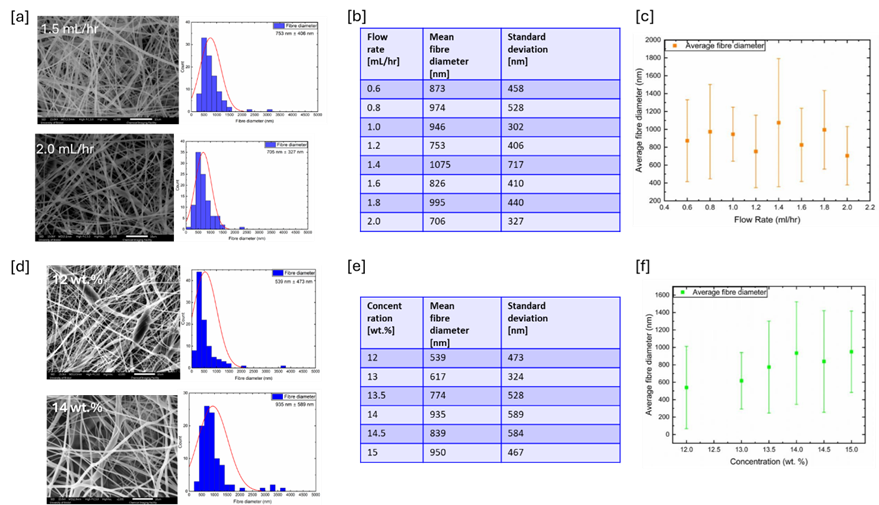
Figure 1 Summary of the effect of flow rate and solution concentration on fibre diameter: [a] and [d] SEM images (scale bar = 10μm) and fibre distribution plot with a Gaussian fit for different flow rates and solution concentration, [b] and [e] Summary data of mean fibre diameters and standard deviation for the different flow rate and solution concentration samples and [c] and [f] Plot of mean fibre diameter against flow rate or solution concentration.
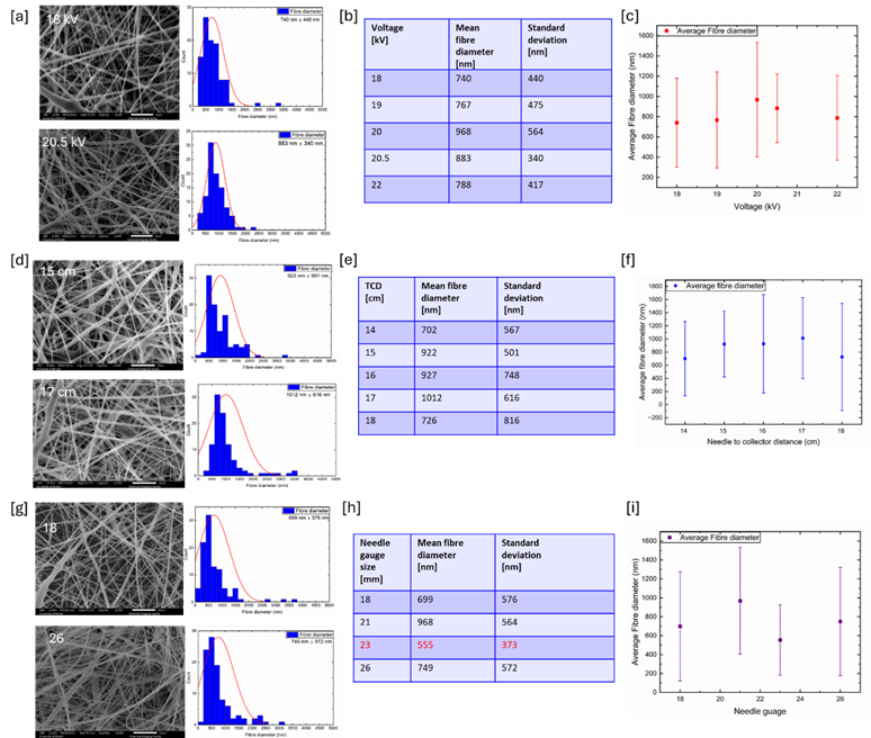
Figure 2 Summary information on the effect of experimental parameters on fibre diameter using a solution concentration of 12.5 wt.%. The SEM images (scale bar = 10μm) and fibre distribution plot with a Gaussian fit, summary data of mean fibre diameters and standard deviation and a summary plot of [a-c] variation in voltage, [d-f] variation in needle tip-to-collector distance and [g-i] variation in needle gauges.
Fused Filament Fabrication (FFF) of vitrimer based material forms for sustainable high-quality composite structures
 Student: Jakub Jakimow
Student: Jakub Jakimow
Supervisors: Dmitry Ivanov, Dominic Palubiski, Ben Woods, Ian Hamerton
This project explored the limitations and challenges of Fused Filament Fabrication in production of composites featuring vitrimer based matrix systems. The project aimed to improve the mechanical properties of FFF produced parts by addressing issues such as poor inter-raster bonding, porosity and anisotropy, all common defects found in the process. Vitrimers were chosen as the matrix of choice due to their highly desirable dynamic covalent networks, increasing recyclability and repairability over typical polymers, crucial factors in sustainable composite manufacture.
The research investigated the effects of chemical modifications to the base vitrimer resin system using two different viscosity altering reagents. Rheological data was obtained for both initial and post cures of the matrices to identify optimal processing conditions for infusion and consolidation in Unidirectional (UD) carbon fibre laminates. Consolidation trials were conducted on the matrices, investigating the effects of compaction pressure and dwell time on the laminate quality, post-comapction samples are shown in Figure 1. Micrographs were taken to assess the laminate architecture.
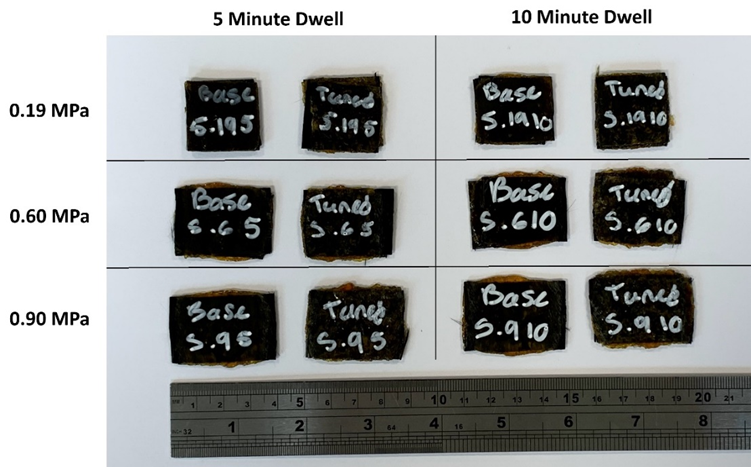
Figure 1 Post consolidation baseline and tuned system impregnated samples at varying compaction pressures and dwell times
It was found that the modified vitrimer system performed unfavourably when comparted to the original vitrimer system. This was likely due to large variations in thermal history in the manufacture process. Initial rheological data found the modified system to have reduced viscosity and therefore favourable processing properties. Micrographs of sample cross sections disproved this, with modified matrix samples exhibiting greatly compromised laminate architecture. Future work will focus on widening and refining the rheological characterisation process, improving consistency of manufacture and healing capabilities of the modified matrix.
Developing Monte-Carlo simulation model to predict the surface erosion profile in composite materials for space applications
 Student: Lucas Lu
Student: Lucas Lu
Supervisors: Giuliano Allegri, Ian Hamerton, Katharine Robson Brown, Rainer Groh
Atomic oxygen (AO) in low Earth orbit (LEO) poses a significant threat to spacecraft materials, as it is highly reactive due to intense ultraviolet (UV) radiation from the sun, which dissociates molecular oxygen into separate atoms. This process predominates at 200 to 700 kilometres, where most satellites operate, and the residual atmosphere is thin.

Figure 1 A rendered image showing the Columbus module and the Bartolomeo platform of the International Space Station (original image adapted and reproduced with permission from Airbus Space and Defence).
Understanding how AO affects materials like polymers and composites and predicting their degradation is crucial for ensuring the longevity and safety of space missions. This report focuses on developing a Monte Carlo (MC) model to predict the AO-eroded surface profile of Kapton H, selected for its well-documented erosion characteristics. The model's accuracy will be validated through experiments in a radio frequency (RF) plasma chamber that simulates the LEO environment by measuring the mass loss of the samples and AO flux. By creating a robust predictive model from Kapton H samples, this research will become the foundation of future predictive model development of enhanced AO-resistant materials, which is critical for future space mission success.

Figure 2 Surface Roughness Profile from Simulation and Experimental Results after Equivalent 6-Month LEO Exposure
Exploring novel high temperature matrix resin composites for advanced engineering applications
 Student: Tierney McArdle
Student: Tierney McArdle
Supervisors: Ian Hamerton, Dong Liu (Oxford), Bassam El Said
The continuous push for performance retention at high-temperatures and improved strength-to-weight ratios has been a crucial factor in developing novel materials for propulsion materials and wider aerospace applications. Advanced composite materials offer superior toughness and lower specific densities when compared to conventional metal alloys. Additionally, retention of mechanical properties at elevated temperature indicates their potential widespread implementation in aerospace applications. Much research has been conducted to develop thermoset resin systems with enhanced thermal and moisture durability properties. The employment of these advanced composite systems in propulsion components would lead to reductions in both component mass and cooling requirements, consequently lowering fuel consumption and exhaust gas emissions.
There has been specific interest into cyanate esters due to their tuneable viscosity properties for resin infusion and high glass transition temperatures, making them suitable for a range of applications. Previous research has incorporated small amounts of polydimethylsiloxane into cyanate ester networks, to reduce moisture absorption and enhance toughness. Susceptibility to water leading to moisture uptake is a key limitation to the widespread application of advanced composites in aerospace and propulsion applications, so a similar approach of incorporating a siloxane into the resin matrix was adopted. Optimisation of the resin composition aims to achieve a balance between moisture resistance, degree of polymerisation, and network architecture; which are crucial factors for the material's performance and ensuring their use in long-term, oxidising environments. However, poor compatibility between siloxanes and cyanate esters has proven to be a historical challenge, often resulting in significant phase separation during manufacture. Although there is some understanding of the cyanate ester resins of this nature, their behaviour when combined with higher concentrations of silicon-containing species remains unexplored, offering a degree of novelty to this body of research. This investigation aims to evaluate the resin system's suitability for practical high-temperature aerospace applications, bridging the gap between laboratory research and real-world implementation. Novel material systems for high-temperature applications are crucial for advancing modern aerospace technologies. Characterising these materials’ mechanical and thermal behaviour will be essential for understanding their performance in harsh environments.
Natural fibre-reinforced composite laminates for future pedestrian footbridge decks
 Student: Ronald Mwesigwa
Student: Ronald Mwesigwa
Supervisors: Eleni Toumpanaki, Steve Eichhorn, Neha Chandarana
Fiber-reinforced polymer (FRP) composites are gaining popularity over steel and concrete materials in construction because they are lightweight, easier to assemble, and do not rust. See Figure 1 for details.
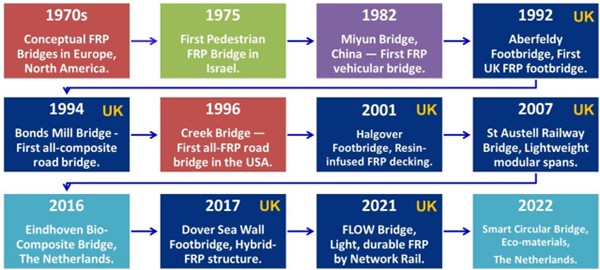
Figure 1 Timeline of FRP composites in bridge construction from the 1970s.
To achieve the 2050 net-zero carbon target, the construction industry is adopting plant-based materials for their carbon retention properties. As a result, FRP composites have advanced to include natural fiber-reinforced polymer (NFRP) composites, which integrate natural fibers, and a synthetic or bio-based resin. However, challenges remain with their long-term durability and resistance to repeated use (fatigue). In this study, non-woven flax/bio-epoxy composite laminates were manufactured using resin infusion and tested to evaluate their performance for footbridge decks. See Figures 2 and 3 for more information.

Figure 2 The process of manufacturing the NFRP Composites (a) Laminate A; (b) Laminate B; and (c) The finished Composite Laminate A after Demolding.

Figure 3 Test specimen preparation: (a) Dimensions specified for the test specimens; (b) End tab attachment; (c) Individual test specimens.
During monotonic tensile testing, the composite laminates broke at an average load of 2 kN, with an ultimate tensile strength (UTS) of 43.4 MPa and a strain of 1%. The UTS was higher than non-woven hemp composites (36.1 MPa) but lower than woven flax composites (63.9 MPa) used in the 3TU bio-based footbridge. In fatigue testing, the laminates had an average maximum stress of 38 MPa at 1.3% strain, showing a consistent stress-strain relationship (R² = 0.99). The test specimens supported a maximum load of 1.8 kN, which is lower than the 5 kN live load used in the 2016 bio-composite footbridge design. Stress levels between 50% and 60% of the UTS improved the fatigue life, while stiffness (Young's Modulus) remained steady under moderate stress but reduced at higher loads (80%–90% of the UTS) due to fatigue damage. Figure 4 shows the testing and analysis process.

Figure 4 Composite laminate testing and analysis: (a) Experimental setup; (b) Monotonic tensile test results and analysis; (c) Fatigue test results and analysis.
These findings highlight the potential of flax composites as lightweight, eco-friendly, and cost-effective materials for sustainable construction, particularly for pedestrian footbridges and lighter infrastructure.
Integrally cooled WrapToR truss structures with hierarchical vascular networks
 Student: Robert Oxford Pope
Student: Robert Oxford Pope
Supervisors: Ben Woods, Laura Pickard, Mark Schenk
High energy physics experiments rely on high-performance tracking detectors composed of silicon sensors mounted on lightweight structures. These structures must not only provide adequate support but also incorporate a network of cooling fluid for sensor thermal management. The efficiency of the detector significantly influences the quality of experimental results. Current state-of-the-art tracking detectors utilise a network of metallic or plastic pipes containing cooling fluids. Despite the adequate cooling performance of this design, future tracking detectors will require more efficient cooling solutions to enhance their performance. Embedding a vascular cooling network within the composite laminate eliminates the need for foreign materials, enhancing thermal coupling, thermoelastic stability and overall through-thickness radiation length. Promising vascular fabrication techniques involve the vaporisation of modified poly(lactic) acid (PLA). This work compares a solvent-based treatment technique with a lesser-known compounding method to modify the PLA. A thermogravimetric analysis is used to quantify the degradation performance of both methods. Carbon composite coupons with embedded vascular channels are manufactured, and imaging techniques are utilised to qualitatively evaluate the feasibility and performance of the embedded channel fabrication.
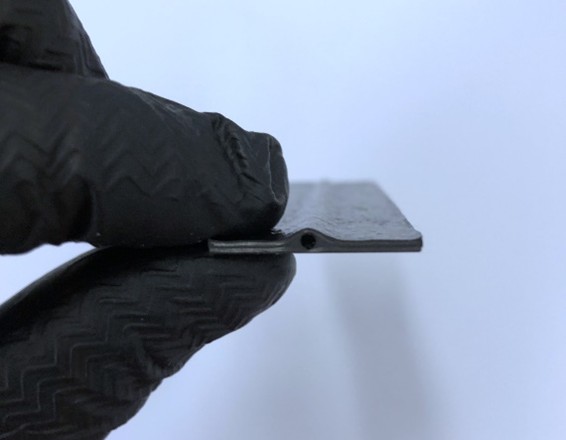
Figure 1 Vaporised empty channel fabricated with treated sacrificial PLA.
![The ALICE Inner Tracking System at the Large Hadron Collider with embedded vascular cooling [1].](/media-library/sites/composites/images/cdt/Image 2 ROP.jpg.png)
Figure 2 The ALICE Inner Tracking System at the Large Hadron Collider with embedded vascular cooling [1].
- B. Abelev et al, “Technical Design Report for the Upgrade of the ALICE Inner Tracking System,” Journal of Physics G: Nuclear and Particle Physics, vol. 41, no. 8, p. 087002, Aug. 2014, doi: 10.1088/0954-3899/41/8/087002.
Thermo-mechanical characteristics of carbon fibre PEEK composites at cryogenic temperatures: Experiments and simulations
 Student: Jula Schroeder
Student: Jula Schroeder
Supervisors: Ian Hamerton, Fabrizio Scarpa, Sebastien Rochat, Jonathan Meegan (Syensqo), Patrick Fairclough (Sheffield), Rachel Tomlinson (Sheffield)
Future aerospace launch vehicles will require lightweight liquid hydrogen fuel tanks. These tanks must utilise load-bearing fibre composites to meet the growing demand for net-zero emissions and sustainability. Thermoset polymers, with their high crosslinking density, become increasingly rigid, especially in cryogenic conditions. This rigidity makes the material more brittle and susceptible to microcracking, leading to reduced strength and failure strain. In response, the industry is shifting from thermoset resins to thermoplastics. For example, polyether-ether-ketone (PEEK), a semi-crystalline thermoplastic polymer, is renowned for its exceptional mechanical properties, wear resistance and chemical resistance.
This study focused on evaluating the thermo-mechanical properties of carbon fibre PEEK composites at cryogenic temperatures, specifically for hydrogen storage applications. Understanding these properties and the material's damage characteristics is essential to validating recent research and further exploring the potential of PEEK-based composites in cryogenic environments.
Thermogravimetric analysis and differential scanning calorimetry were utilised to determine the polymer characteristic temperatures (glass transition temperature, Tg ≈ 145 °C; melting temperature Tm ≈ 344 °C). Initial molecular dynamics simulations showed promise in modelling PEEK’s thermal behaviour, predicting a Tg of 153 °C and a Tm between 306 °C and 347 °C, laying the groundwork for future research on its performance at cryogenic temperatures (Figure 1).
Tensile tests were performed on eight-ply AS4/PEEK laminates before and after ten cryogenic cycles. The results indicate that the tensile modulus for the [0]8 laminate increased by 26 GPa following cryogenic cycling. In contrast, the modulus of the [90]8 and [0/90]2S laminates remained unchanged. Imaging techniques, including optical microscopy, scanning electron microscopy, and computed tomography, confirmed the absence of microcracking, aligning with literature for the three 8-ply layups. However, damage characterisation revealed flaws in the compression moulding process, with larger voids and delamination present before any cryogenic cycling. These defects limited the material's performance and complicated the visualisation of potential microcracks.
This project was supported by Syensqo.
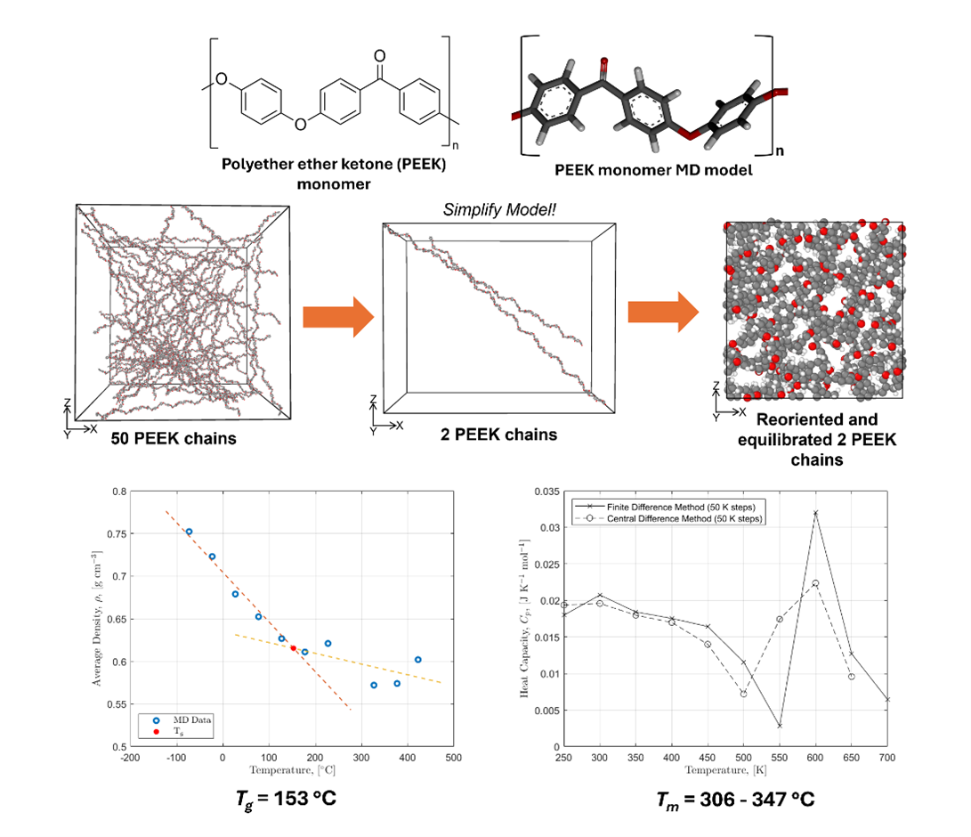
Figure 1 Molecular Modelling set-up of PEEK chains, with 20 monomers and the resultant Tg and Tm from the simulation.
Micro mechanical modelling for the prediction of mechanical performance of Ceramic Matrix Composites (CMCs)
 Student: Cyril Varghese Thankachen
Student: Cyril Varghese Thankachen
Supervisors: Luiz Kawashita, Vasav Dubey, Giuliano Allegri, Bassam Elsaied
Ceramic Matrix Composites (CMCs) made of silicon carbide fibres and matrix (SiCf/SiC) are known for their mechanical robustness at very high temperatures (1200°C continuous operation) making them suitable for usage in extreme environments such as combustion chambers/sections in turbofan engines. This paper presents a brief introduction into a wider ongoing project on the development of a micro-mechanical framework to predict the mechanical/progressive damage and oxidative behaviour of such CMCs in operation conditions. As a first step, a Continuum Damage Mechanics (CDM) model developed by the Bristol Composites Institute for the finite element package Abaqus/Explicit has been tested in terms of its accuracy and robustness, but also potential known issues involving mesh dependency or bias. The constitutive model hinges on the Christensen failure criterion for damage initiation and a volume-based energy regularisation for damage evolution. The paper reports on the effects of finite element type, mesh density, element aspect ratio, and mesh topology on the damage energy dissipation in the cube. Three mesh topologies were tested in four different stress/strain states. Results show a considerable mesh bias in terms of the total energy dissipation in structured meshes when the element aspect ratios are high. This is attributed to the volume-based characteristic element length used within the material subroutine for energy regularisation.
Finally, potential improvements to this model are proposed including the computation of a more accurate smeared crack plane at each element integration point. This will inform future work on applying such models for these CMCs at the micro-scale.
